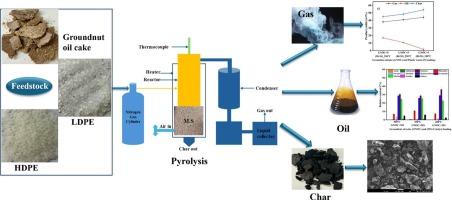花生脱油饼催化共热解可持续生产腈、芳烃和富烃热解油
Q1 Environmental Science
引用次数: 0
摘要
以高密度聚乙烯(HDPE)、低密度聚乙烯(LDPE)和废聚碳酸酯(P)为原料,对花生脱油饼(GNOC)进行了催化共热解研究,优化了热解油收率和组成。在分子筛(MS)催化剂的存在下,研究了温度、催化剂和生物质/塑料比(90:10,80:20,70:30)的影响。在非催化条件下,热解油的产率较低,约为28 wt%。而催化热解使产率提高了约40 wt%,并使油中含有腈、酰胺、碳氢化合物和芳烃。催化共热解以70:30的gnoc / ldpe /HDPE比例在热解油中产生~ 95%的芳烃和~ 85%的碳氢化合物,表现出协同降解行为。碳数分析表明,LDPE有利于C6-C10烃的合成,HDPE延伸至C20, P有利于重馏分>; C20。这些发现证明了GNOC与各种塑料和质谱催化剂催化共热解生产高质量、燃料和有价值的富含化学物质的热解油的潜力。本文章由计算机程序翻译,如有差异,请以英文原文为准。

Catalytic co-pyrolysis of groundnut de-oiled cake for sustainable production of nitrile, aromatic, and hydrocarbon-enriched pyrolytic oil
Catalytic co-pyrolysis of groundnut de-oiled cake (GNOC) with high-density polyethylene (HDPE), low-density polyethylene (LDPE), and waste polycarbonate (P) was studied to optimize pyrolytic oil yield and composition. The effects of temperature, catalyst, and biomass-to-plastic ratios (90:10, 80:20, 70:30) were studied in the presence of molecular sieves (MS) catalyst. Under non-catalytic conditions, lower yields of pyrolytic oil, ∼28 wt%, were obtained. Whereas catalytic pyrolysis enhanced the yields up to ∼40 wt%, and enriched the oil with nitriles, amides, hydrocarbons, and aromatics. Catalytic co-pyrolysis at a 70:30 GNOC-to-LDPE/HDPE ratio produced ∼95% aromatics and ∼85% hydrocarbons in the pyrolytic oil, demonstrating synergistic degradation behavior. Carbon number analysis showed that LDPE favored the synthesis of C6-C10 hydrocarbons, HDPE extended up to C20, and P contributed to heavier fractions > C20. These findings demonstrate the potential of catalytic co-pyrolysis of GNOC with various plastics and an MS catalyst to produce high-quality, fuel and valuable chemical-rich pyrolytic oils.
求助全文
通过发布文献求助,成功后即可免费获取论文全文。
去求助
来源期刊

Bioresource Technology Reports
Environmental Science-Environmental Engineering
CiteScore
7.20
自引率
0.00%
发文量
390
审稿时长
28 days
 求助内容:
求助内容: 应助结果提醒方式:
应助结果提醒方式:


